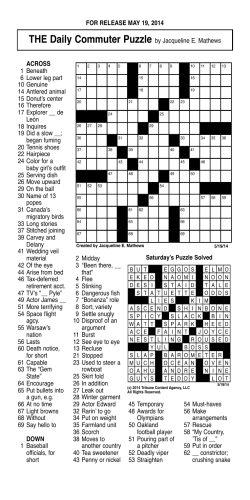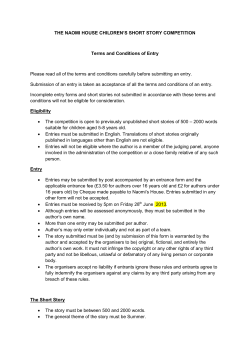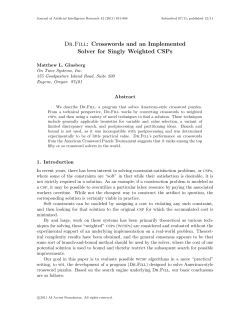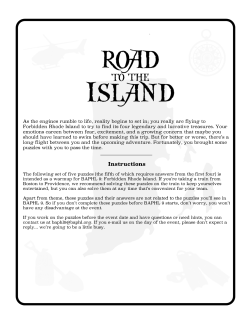
Themes Become a Crossword Super Solver
Become a Crossword Super Solver William Johnston · 19 January 2010 Newton Community Education Themes C U J O The theme of a crossword puzzle is the organizing principle that links the longest entries. Most crosswords published in the United States have a theme. If the puzzle has a title, it may obliquely suggest the theme. U P O N B B U B S Q F U S S E D A S P I R E S S G I T O Y B U Z A M E E L O L S O A T S U I R T O R K E T E A U S A I N M S I S E C T R E N L A Z I N G A G E D A M I N Z O E T A X E L T R Y A D O R S T O R L A I G F E H A T Z O A Y R E D D R I S E I N T R B A R E S O S P E N T I C G U L L OW E S C H E H O G M S S V E S P E C E A R G L U N O R O O M R R S E S S E The five theme entries in this puzzle are common joke shop items. A S S A M M A Y B E E L M E R I R A Q R A G U A T T A P S S T S I L O H M O S N E C E B O L R R A D I A A R N I I N G R G M I R E P A W P L E P E A S S H I N S A F I R E S A N T I C T A C T O E E N D I N G E S C M E A U N K N E A S T E R H A N D O M R A D U N H A MA W T E R I A M E G N A T E L T R Y A A T MO OW R N S I N S L O L L E R T E R O S Y U T U R N M E R I T P R E P S Three horizontal 15-letter entries are clued as “X” and a central vertical 15-letter entry is clued as “X X X.” B A W L O D I E L A I MA P R S P E D T I G E R C A L M A P L O M A B L P O P L I E T A A L Y T S A T T T E A N L A W G T O R L E I R MA L A A G A T I N C O T O R S L E T H E D I A N C MO A R T I C M P O T R I T A D E R E G I S E E L N L A L A V A L M A A N J O N E A C H R U L O N O G B L A O N N K G A U N I T Y T O N Y A R X O I T S M D L I P E E N The black squares of the grid echo the double-L theme of this puzzle. MO O D M U N I I C E S H A R A J E R E A M I L N T O I E S T P M T F U A R I E C U R B H E E L O R S O M E M L O U R M Y E N E L A S J I A N O R E A N I T A G E L T I R A E C O N C E P A R G I L T L A V O U N A E O P N O T O I N I L E D E E C E D G E R G L O O R R I K A I S E R E S H O W T I M E R O N D E A S C A P S E E Y A L I A R S E M I U R S A T N U T E X S I R T A This puzzle names famous beheaded people. Their “heads” lie nearby but detached from their bodies. Theme attributes Theme entries are usually longer than all the other entries in a puzzle. Typically, there may be three horizontal theme entries of 12–15 letters, or four theme entries of 9–11 letters. Theme entries must be presented in a symmetric arrangement in a puzzle. It is crucial that theme entries be parallel in construction. Editors insist on consistency in themes. Themes provide entertainment and satisfaction for the solver. When a theme is discovered, it helps the solver complete all areas of the puzzle. Themes provide a way for the crossword constructor to advance the art and craft of puzzle-making. Typical themes Categories: Theme entries may all be members of a specific category. Puns: Theme entries may all be puns related to a single topic. Wordplay: Adding, deleting, or changing letters in common phrases can result in humorous new phrases that are then clued. See the example on page 3. Hidden words: Multi-word phrases that contain hidden words can be a theme. Quip: An amusing or pithy quotation or quip can be a theme, but it must break into symmetric entries. Sometimes the author’s name can be included. Clue-related: Sometimes the same clue can be used for all the theme entries. Special event: Holidays, anniversaries, or birthdays can provide a theme. Rebus: A small word, symbol, or picture can occupy a single square in several locations. This is a tricky theme for novice solvers. Things to avoid in themes Constructors and editors try to avoid gruesome or tasteless topics (see puzzle shown at the bottom on this page), and avoid topics that are too specialized to appeal to a wide solving audience. Most of the puzzle will not consist of theme entries; about 45–50 squares in a typical 15 x 15 puzzle should be theme related. If a constructor tries to fit too many theme entries in a puzzle, this makes filling the puzzle grid much harder, and it is likelier that obscure or rare words will be needed to complete the diagram. Aside from the major theme entries, most constructors avoid adding small words that are only tangentially related to the theme. One exception is that a small “helper” entry may be placed in a corner of a puzzle if it helps explain the theme in a puzzle that has no title. page 1 Become a Crossword Super Solver William Johnston · 19 January 2010 Newton Community Education S P I C S I L E W E L L F L E T A G E T S G L E E O L D P G O S S I P D O T I M E S P A D E R R E A M A S S I S I T I E P I N R O A N F A T O N I S N I T E P R A E T S O F A N T O B I S S T L L S B E T O S E A M T E S R O L F E M I L T A X I E D S R Q U I S A S L E P N O R E R A A T Z S S E E N I G M A S I R H A N T A S T E D S K E L E T O N H U E D Y A P S E S T H C E 180-degree symmetry. The diagram looks the same upside down. All typical crosswords have this feature. Grids The grid is the pattern of black and white squares that the solver fills in. You can use graph paper or computer software to help design and fill crossword grids. Grid features Grids are almost always square. Grids usually have an odd number of squares on each side. Common sizes for grids are 15 x 15 for weekday puzzles and 21 x 21 for Sunday puzzles. The maximum word count in a 15 x 15 themed puzzle is 78 words. No more than about 1/6 of the squares in the grid should be black. Every white square in the grid must appear in an Across and a Down word. The black squares of the grid must not divide the puzzle into unconnected areas. L E W D P A N E L T R A S I R A E N I T S K E E P O A W N M I A N T D S I F E L E O O K OW E P E R S R S B O R W A I N E S O S M E M R E W T O K E N L I N I A S E S H E E L E A R P U T O R A S K A G E S M E N T O A B E L L D O T D A Y R V S U I I N G S C T A T S O T S O A S K S F O R J U L Y F O U R T A H S T S R O O U S L A R E A R E E S K N E E L Y E A T S U S T A P S S T 90-degree symmetry. A quarter turn maps the grid onto itself. Grid symmetries The pattern of black squares must have 180-degree symmetry. That is, if you turn the diagram upside down, it looks the same. In addition to 180-degree symmetry, some puzzles also have 90-degree symmetry. In addition to 180-degree symmetry, some puzzles also have mirror symmetry. On rare occasions, a puzzle will have mirror symmetry only, without 180-degree symmetry. Things to avoid in grids S H O U T W O O S H G R H A I M C L I N G H O N O R U P P E R P A L A T I N A T E M I S R E A D L A N G L E Y MA F I E L E C I D I D I B O N S E R I N G R D E S E P A F O X I T T L E D A E S E L A L U G A L D I R E R H I N J U D A A T T A V B I A L R A M A G I N O T T E A N A T N T E A L C T I O E S R A L A N D T I P P E R G O R E S P I C E T O N E R O N H I O T N I N N Y S A S E S R U H R A R A B M A N Y N I C A D E X T R A R E A D Y G U S T U N D O E G A N Mirror symmetry in two axes. S P E D L I V E I T E M B A S S I U T A H N S A L A D O G E E U N I T T A R A T H R O W I N T H E T O W E L L A N P U F A C C I D E N T R E P O R T S S L A T H O P I E U R O S O R E N S P I E D P A E S E N A I L E D N A S I T S S T A N D A R D E N G L I S H D E R C O E T A K E A T F A C E V A L U E Mirror symmetry in four axes. Two-letter words are not allowed in standard puzzles. Avoid having too many three-letter words. A maximum of 8–15 three-letter words is ideal. Avoid “cheater” black squares added just to make filling the grid easier. If a black square can be removed without changing the total number of words in the grid, it is a cheater, unless it is required for thematic reasons. Avoid large clumps of black squares. Avoid having just one entry as a mode of access into a region of the grid. Solvers should have two ways of getting into every region. This guideline is violated in the top diagram shown at the left. Grid Activity The following grids are unacceptable for different reasons. Can you explain why each grid fails to meet the typical requirements for a puzzle? Diagram A Diagram B Diagram C Diagram D page 2 Become a Crossword Super Solver William Johnston · 19 January 2010 Newton Community Education Improving Your Solving Commonly used words ERA AREA ARENA ESTATE ERE ERIE ERASE TSETSE ELI ALOE EERIE STEREO ONE EDEN ENTER ODESSA ORE ARIA OPERA ELAINE ATE ANTE IRATE ORIOLE ALE ELSE ALONE ENAMEL ETA IDEA IRENE ARARAT ALI ASEA AROMA ORIENT ENE OREO ERATO ARENAS These are some of the most common short words found in crosswords. As you gain practice in crossword solving, you will find that certain words crop up over and over again. This has to do with patterns of letters, such as alternating vowels and consonants, and frequency of common letters, that make building the puzzle easier for the constructor. Some of these words are very common, and others are rare enough that they seem to be seen only in crosswords, and they are sometimes known as crosswordese, such as ETUI, OLEO, ORCA, and so on. Familiarity with common fill words and crosswordese can help speed your solving. Finding the easy ones Some people like to quickly scan through a puzzle to see which entries they are sure they know. Look at the clue set and see if any clues stand out as ones that you think you can solve right away. Fill-in-the-blank type clues are one kind of clue that can provide an early foothold in a puzzle. Some sports or movie trivia clues may be gimmes. You can also often be confident about clues involving areas in which you have expertise. Method of attack How do you proceed in solving a puzzle? Some solvers read all the Across clues in order and then the Down clues, proceeding methodically in that order, repeating as necessary. Others skip around in the diagram or clues with no particular method, gradually completing the puzzle piecemeal. Activity Cardinal point _ _ S T _ _ S T Musical key B M _ _ O R B M _ _ O R Car damage D _ N _ D _ N _ Slow movement L _ _ _ O L _ _ _ O “___ boy!” _ T _ A _ T _ A Mummy’s spot Country name Another approach is to try to always build off of words you have already entered, gradually filling the grid like an ever-enlarging amoeba. With this approach, you already have at least one known letter in each new word you enter, and you can be more certain the answers are correct because you are building on known letters. The fastest solvers at the annual crossword competition largely use this approach. Ambiguous fill Sometimes you will find that there are two or more words that seem to work as an answer. It may be possible to fill in some letters, even though you aren’t yet sure what the final answer is. For example, the clue “Make edits” could be AMEND or EMEND. So, you can fill in _MEND. You will eventually figure out which answer is correct, but in the meantime you should enter as many likely letters as you can. Watch out for clues where the constructor has deliberately set traps! For example, the clue “Something in a shell” might be used for PIE, or PEA, or even OAR. _ _ Y P T _ _ Y P T Ambiguous Fill Activity _ E _ _ Explain why each of the clues at the left is ambiguous by finding more than one answer that fits with the given letters. _ E _ _ page 3 Become a Crossword Super Solver William Johnston · 19 January 2010 Newton Community Education Tackling Clues The clues in a puzzle are what the solver uses to discover the answers. You will find that certain conventions apply to clues in puzzles. Rules for clues The part of speech of a clue must match the part of speech of the answer. Clues should be accurate, but they may be deceptive. Clues will be short, since there are space limitations in newspapers. If an answer is an abbreviation, the clue will include an abbreviation itself as a cue, or include “(abbr.)” at the end. If an answer is a common word from a foreign language, the clue will usually use a reference to that language within its wording. Difficult entries should have easy clues, or they should be crossed by words that all have easy clues. The level of difficulty of clues should be appropriate for the venue of the puzzle and the day of the week it will appear. Varieties of clues Straight definition: Most crossword clues are simple definitions of their answers. Tricky Clue Activity Can you solve these clues? The question marks at the end indicate these are tricky clues. Pole star? S — — N — — A — — L — — U — — Alliteration or rhyme: Clues can use alliteration or rhyme to avoid monotony. Fill-in-the-blank: Some entries can only be clued with a fill-in-the-blank phrase. Trivia: Solvers enjoy learning new things, so an interesting fact that can clue a common answer in a fresh way is usually welcome. Punny or tricky: A question mark often indicates that the solver needs to view a clue in a non-standard way to solve it. Humorous: Solvers welcome offbeat clues to words. Old tool for working on logs? L — — D — — R — — L — — — Clue variety Where mates are often found? You can see from the examples below that it is possible to write clues of different varieties or difficulty levels for the same word. N — D — — A — — — S — — Blessed events? N — — — Z — — — — Genesis garden Paradise Idyllic spot Sandwich cookie Nabisco treat Hydrox alternative Run off to wed Split to unite Get hitched quick Jeannie portrayer Barbara 1950s British prime minister Steinbeck’s “East of ___” Snack since 1912 Stackable snack Dunkable dessert Run for your wife? Take the honey and run? Bolt together? Temptation location Fall locale First place? Round of snacking? Food that’s been kosher since 1998 It may get a licking after dinner What running mates do? Take part in a secret joint venture? Choose the window instead of the aisle? Takes back the lead? E — — — S — — — Spoke more than once? — — — I — I — Bring up the rear? O — O — — — Scratch post? T — — — page 4 Become a Crossword Super Solver William Johnston · 19 January 2010 Newton Community Education Resources Books for Solvers Amy Reynaldo. How to Conquer the New York Times Crossword Puzzle. ISBN: 0-312-36554-3 Patrick Berry. Crossword Puzzle Challenges for Dummies. ISBN: 0-764-55622-3 Coral Amende. The Crossword Obsession. ISBN: 0-425-18157-X Matt Gaffney. Gridlock. ISBN: 1-560-25890-X Marc Romano. Crossworld. ISBN: 0-767-91757-X Will Shortz. Wordplay. ISBN: 0-312-36403-2 Internet Links for Solvers Puzzle Pointers — links to free daily puzzles http://www.fleetingimage.com/wij/xyzzy/nyt-links.html Crossword Fiend blog and forum — discussions about daily puzzles http://www.crosswordfiend.com Wordplay blog — discussion of New York Times daily puzzles http://wordplay.blogs.nytimes.com XWord Info — solving aids, tips, statistics about puzzles http://www.xwordinfo.com Answers to Activities Grid Activity A. Four squares do not have both Across and Down words going through them. B. There are four 2-letter entries. C. The diagram does not have 180-degree symmetry. D. The diagram has 80 entries. The maximum word count for this puzzle size is typically 78 entries. XWord Blogosphere — links to blogs with daily puzzle answers http://www.xwordinfo.com/blogs.aspx OneLook — online dictionary search with wildcards http://www.onelook.com Crosswordese — word of the day http://www.crosswordese.com Cruciverb — crossword constructors resource center http://www.cruciverb.com Ambiguous Fill Activity EAST, WEST B MAJOR, B MINOR DENT, DING LARGO, LENTO ATTA, ITSA EGYPT, CRYPT PERU, REBA Tricky Clue Activity SANTACLAUS, SLIDERULE, ENDGAMES, SNEEZES, ERASES, RADII, MOON, ATM page 5
© Copyright 2025





















